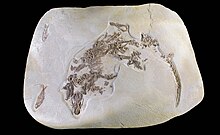Pantolestidae
| Pantolestidae Temporal range: Late Cretaceous–Oligocene |
|
|---|---|
 |
|
| Palaeosinopa, from Wyoming eocene | |
| Scientific classification | |
| Kingdom: | Animalia |
| Phylum: | Chordata |
| Class: | Mammalia |
| Infraclass: | Eutheria |
| Order: |
Cimolesta McKenna, 1975 |
| Suborder: |
Pantolesta McKenna, 1975 |
| Family: |
Pantolestidae Cope, 1884 |
| Genera | |
|
Bessoecetor |
|
Bessoecetor
Bisonalveus
Buxolestes
Palaeosinopa
Pantolestes
Pentacodon
Dyspterna
Pantolestidae is an extinct family of semi-aquatic, non-placental eutherian mammals that took part in the first placental evolutionary radiation together with other early mammals such as the leptictids. Forming the core of the equally extinct suborder Pantolesta, the pantolestids evolved as a series of increasingly otter-like forms, ranging from the Middle Paleocene (60 mya) Bessoecetor to the Late Eocene (Ergilian) (50-33 mya) Gobiopithecus and Kiinkerishella. They first appear in North America, whence they spread to Europe.
The pantolestids were fish predators with a body length of about 50 centimetres (20 in) and a tail about 35 centimetres (14 in) long. The anatomy of these archaic "insectivorous" mammals is best known through well-preserved Middle Eocene Buxolestes specimens found at Messel in Germany and a few other less complete specimens, such as the Palaeosinopa found at Fossil Butte in Wyoming, estimated to have reached body weights of up to 1,400 grams (3 lb), making them relatively large early mammals.
They had moderately strong canines and multi-cusped cutting teeth supported by the strong jaw muscles to which cranial cavities were adapted. This combination of dentition and muscles has been interpreted as an early adaptation to a hard diet such as clams and snails.
...
Wikipedia
